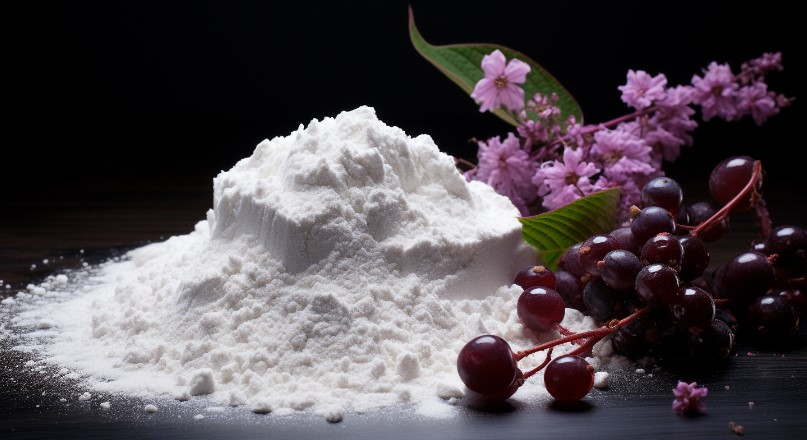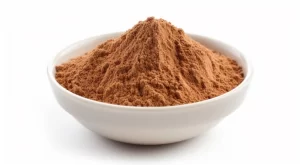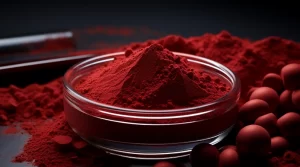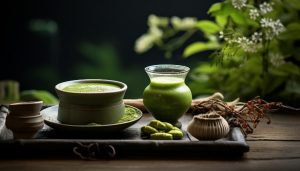レスベラトロールを多く含む食品と飲料

レスベラトロール
レスベラトロール は、ブドウ、赤ワイン、ブドウジュースに含まれることで知られる生理活性物質だが、ブルーベリー、クランベリー、ピーナッツ、さらにはピスタチオにも含まれている。自然界では レスベラトロール は植物を破壊する菌類と戦う天然の殺菌剤であり、植物の健康防御システムの主要な構成要素である生物学的に活性な物質である。
人々が消費するとき レスベラトロールレスベラトロールは、さまざまな種類のヒト細胞を刺激し、行動にも影響を与える。例えば、レスベラトロールは心臓幹細胞を活性化する。心臓幹細胞は通常心臓の中で休眠状態にあるが、ストレスに反応して心臓組織を再生することができる。スーチョー大学、昆山第三人民病院、南京医科大学の科学者たちは、マウスの心臓幹細胞に対するレスベラトロールの効果を研究した。健康な正常マウスにレスベラトロールを1週間毎日投与したところ、疾患がない場合でも、レスベラトロールは心臓組織中の心臓幹細胞の数を0.7倍増加させることがわかった。
心臓発作を起こしたマウスに100万個の心臓幹細胞を注射し、心臓を救えるかどうかを調べた。幹細胞とともにレスベラトロールを投与したマウスでは、心臓の血管の数が増え、心臓幹細胞の生存率がほぼ2倍になった。
レスベラトロールの実際の摂取量に関する問題は、赤ワインやほとんどの食品に含まれる量が少なすぎることである。このため、レスベラトロールは、生理活性物質を実際の食品から摂取するよりも濃縮サプリメントから摂取した方がよいという、数少ない例外の一つかもしれない。
.
ゼアキサンチンを多く含む食品
ゼアキサンチンはカロテノイドに属する生理活性物質である。とうもろこしやサフランにオレンジがかった黄色を与える色素だが、ケール、からし菜、ほうれん草、クレソン、カラスムギ、ワラビなどの葉菜類にも多く含まれる。ゼアキサンチンは、アジアのハーブティーやスープ、炒め物に使われる赤くて平たい楕円形の実、ゴジベリーにも多く含まれている。この生理活性物質は目の健康に非常に重要である。ゼアキサンチンを含む食品を食べると、光を感知して脳に伝える目の奥の層である網膜にゼアキサンチンが蓄積される。臨床研究によると、ゼアキサンチンを摂取することで、加齢黄斑変性症の失明の影響から目を守ることができる。
広州の済南大学と中国の深圳第三人民病院の科学者が、幹細胞に対するゼアキサンチンの効果を研究した。彼らは脂肪吸引でヒトの脂肪から幹細胞を取り出し、ゼアキサンチンに暴露した。これらの幹細胞は、ゼアキサンチンにさらされていない幹細胞よりも生存率が高く、炎症の兆候も少なかった。次に科学者たちは、ゼアキサンチンが幹細胞が病気によって損傷を受けた臓器を救うのに役立つかどうかをテストした。ヒトの脂肪組織から採取した間葉系幹細胞200万個を、肝臓の機能が低下したマウスに注入し、マウスの肝臓を再生させた。一部のマウスにはゼアキサンチンを投与した幹細胞を注入し、残りのマウスには未処理の幹細胞を注入した。7日後、一般的な幹細胞療法では肝臓の損傷が約半分に減少した。しかし、ゼアキサンチンで処理した幹細胞を注射したマウスでは、幹細胞は同じ期間で肝臓の損傷を75%減少させた。
この研究結果は、ゼアキサンチンを含む食品を摂ることが、臓器再生における幹細胞のパフォーマンスに寄与する可能性を示唆している。
クロロゲン酸を豊富に含む食品
クロロゲン酸もまた、コーヒーだけでなく、紅茶、ブルーベリー、桃、新鮮なプラムやプルーン、ナス、さらにはタケノコにも豊富に含まれる強力な生理活性物質である。抗炎症作用、血管新生作用、降圧作用がある。また、幹細胞を保護する効果もある。中国の南昌大学の研究者たちは、クロロゲン酸が臓器の治癒と再生に関与する間葉系幹細胞の生存にどのような影響を与えるかを研究した。その結果、幹細胞がクロロゲン酸にさらされると、ストレスに強くなり、生存率が倍増し、体の臓器の健康維持に関与する能力が高まることがわかった。
ブラックラズベリー
ブラックラズベリーの濃い色と酸っぱい味は、エラグ酸、エラジタンニン、アントシアニン、ケルセチンといった多くの強力な生理活性物質が含まれていることを示している。実際、ブラックラズベリーから作られた栄養補助食品は、大腸がん患者や糖尿病予備軍に効果があることが臨床的に示されている。ブラックラズベリーに含まれるエラグ酸は幹細胞を活性化する。ソウルにある高麗大学アンナン病院の研究者たちは、メタボリックシンドロームの患者51人を対象にブラックラズベリーの効果を研究した。メタボリックシンドロームとは、肥満、高血糖、高血圧、高中性脂肪、低HDL(善玉コレステロール)などの危険な健康状態の集合体であり、これらの状態にある人は心血管疾患のリスクが高い。研究者たちは研究開始時に患者の血液を採取し、循環している幹細胞の数を測定した。その後、ブラックラズベリーの粉末かプラセボを12週間毎日摂取させた。
その結果、ブラックラズベリーの粉末を食べた人は、循環内皮前駆細胞が30%増加したのに対し、プラセボを食べた人は、メタボリックシンドロームのために幹細胞が35%減少していた。ブラック・ラズベリー・パウダーを食べた人の血管の硬さを測定したところ、12週間にわたって血管の硬さが減少した。
チャイニーズ・セロリ
アジアでは一般的な野菜であるチャイニーズ・セロリは、西洋のセロリよりも茎が細く、風味が強い。本場の中華料理店ではたいていメニューに載っているので、中華風の炒め物などで食べたことがあるかもしれない。チャイニーズ・セロリの葉、茎、種子は食用になり、健康を促進するさまざまな生理活性物質が含まれているが、そのひとつが3-n-ブチルフタレイン(NBP)である。3-n-ブチルフタレインが重要なのは、2002年に中国の規制当局から脳卒中患者の神経保護治療薬として医師が使用する医薬品として承認されたからである。セロリ種子エキスを含むサプリメントにも含まれる3-n-ブチルフタレインは、脳循環を改善し、脳の炎症を抑え、神経の成長を可能にし、脳卒中による脳の損傷を軽減する可能性がある。
中国のスーチョー大学の研究者たちは、3-n-ブチルフタレインが脳卒中患者の回復にどのように役立つかを研究した。急性虚血性脳卒中とは、血栓が血流を妨げ、脳の一部を死に至らしめる病気である。試験では、3-n-ブチルフタレインを経口投与された患者もいれば、標準的な治療のみを受けた患者もいた。治療の7日後、14日後、30日後に採血が行われた。すべての患者において、血液中の幹細胞数は脳卒中直後から増加しており、これは人の再生健康防御システムとして予想される反応であるが、標準治療のみを受けた患者では、幹細胞レベルは7日目以降に減少した。対照的に、3-n-ブチルフタレインによる治療を受けた患者では、循環幹細胞は着実に増加した。30日目までに、3-n-ブチルフタレインで治療された患者の循環幹細胞レベルは、標準治療のみの患者よりも75%高かった。脳のCTスキャンによると、3-n-ブチルフタレインを摂取した患者は、風の部分の血流も改善していた。
この結果は、3-n-ブチルフタレインの薬剤型から得られたものであるが、中国産セロリに含まれる生理活性物質が幹細胞を活性化する特性を持つことを示唆しており、脳卒中などの大病後の臓器治癒や再生に役立つ可能性がある。
マンゴー
マンゴーは非常に甘く、オレンジ色の果肉を持つ石果で、生食、加熱調理、乾燥、ピクルス、または他の食材と一緒に調理して食べることができ、東南アジアやラテンアメリカの料理によく使われる。マンゴーには、果肉にオレンジ色を与える様々な生理活性カロテノイドが含まれているが、マンゴーサイドというユニークな生理活性物質も含まれており、抗腫瘍作用、抗糖尿病作用、再生作用がある。実験動物において、マンゴーはインスリンを生成する膵島のβ細胞を再生させることにより、血糖コントロールを改善することが示されている。
中国南西部の四川省医学科学院と四川人民病院、四川大学、楽山人民病院の科学者たちは、マンゴーがマウスの膵臓の膵島β細胞の数を67%増加させ、また再生とインスリン生成の遺伝子を活性化させ、それによってマウスが分泌するインスリンの量を増加させることを発見した。他の科学者たちは、マンゴーが骨の再生を促進することを示している。これらの研究は、マンギフェリンの注射によるものであるため、マンギフェリンの摂取量に直接換算することはできないが、マンギフェリンに重要な生物活性があることを示唆する結果である。
赤ワイン
赤ワインを適度に飲むことは健康に有益である。中国の台北退役軍人総合病院の研究者たちは、30代の健康な80人の幹細胞を研究した。彼らは赤ワイン(グラス半分)、ビール(1缶)、ウォッカ(小グラス1杯)、水のいずれかを3週間毎日飲んだ。研究期間中は、上記の飲料の他に、お茶、グレープジュース、その他のアルコール飲料を飲むことは禁止された。試験開始時、血圧、幹細胞レベル、その他の身体的パラメーターは全員同じであった。
3週間後の血液検査では、赤ワインを飲んだ人の血液中の内皮前駆細胞レベルが2倍になっていた。ビール、ウォッカ、水を飲んだ参加者は、同じ効果は得られなかった。これらの幹細胞が赤ワインやレスベラトロールにさらされると、移動する能力が高まり、血管を形成し、生き残ることができた。さらに、赤ワインを飲んだ人は、血管が拡張する能力が35%増加した。また、赤ワインを飲む人は、血液中の強力なシグナルである一酸化窒素の量が50%も多かった。一酸化窒素は血管の拡張を助けるだけでなく、血管新生を刺激し、治癒を促進し、幹細胞を活性化するシグナルを送る。赤ワインに関しては、多ければ多いほど良いというわけではない。研究者の報告によると、この効果は1日グラス1~2杯のワインで見られるが、飲む量が多ければ多いほど、その効果は小さくなる。高濃度のアルコールは幹細胞にダメージを与え、臓器を再生する能力を妨げる可能性があることを知っておくことは重要だ。つまり、食事におけるほとんどの食品と同様、適度な摂取が重要なのだ。イタリアのマリオ・ネグリ薬理学研究所の研究者たちは、赤ワインとその心臓血管疾患への影響に関する13の臨床研究を分析した。分析の結果、赤ワインを飲むと動脈硬化のリスクが32%低下すると結論づけた。
緑茶
緑茶には、よく研究された多くの健康効果があるが、そのひとつが再生システムの活性化である。これは喫煙者を対象に研究されている。化学的には、喫煙は血管の内膜を焼き、動脈硬化や心血管疾患のリスクを高める。喫煙は幹細胞にもダメージを与え、循環している幹細胞の数を減らす。喫煙者の血液中の幹細胞は非喫煙者より60%少なく、これも喫煙を勧めない理由の一つである。
韓国の全南大学病院と日本の名古屋大学大学院医学系研究科の研究者らは、喫煙者の幹細胞に対する緑茶飲用の効果を研究した。彼らは6年間喫煙していた30代後半の若者20人を集め、2週間毎日4杯(計56杯)の緑茶を飲んでもらった。研究の始めと終わりに被験者の血液を採取し、存在する循環内皮前駆細胞の数を数えた。その結果、緑茶を飲むと、2週間で循環幹細胞の数が43%増加した。
研究期間中、緑茶は喫煙者の血管の健康状態も改善し、血管拡張反応が29%増加した。研究室では、緑茶とそのカテキンが脳、筋肉、骨、神経の再生を刺激し、創傷治癒を促進することが科学者によって発見されている42。42 緑茶が全身の再生システムに良いということも、緑茶を飲むことを勧めるもう一つの理由である。
紅茶
紅茶は発酵茶であり、緑茶に比べてポリフェノールの含有量が少ないため、健康上の利点はないと考えられていた。しかし、イタリアのラクイラ大学の研究者たちは、紅茶が実際に幹細胞を動員できることを明らかにした。この効果を研究するために、最近軽度から中等度の高血圧と診断されたが、まだ薬物療法を受けていない50代の19人を募集した。被験者たちは他に持病もなく、薬も飲んでいなかった。被験者には、1日2回、1杯の紅茶かプラセボが1週間飲まされ、紅茶にはミルクや砂糖などの添加物を加えないように言われた。研究者たちは彼らの血液中の循環内皮細胞の数を測定した。週間後、紅茶を飲むと循環内皮前駆細胞が56%増加した。1日2杯の紅茶を飲むと、血管系の健康も改善される。これは、紅茶を飲むと血管が拡張する能力が高まることからもわかる。紅茶が食事性脂肪から血液循環を保護するかどうかを調べるため、研究者たちは被験者に脂肪分の多いホイップクリームを食べさせた後、紅茶を飲んでもらった。ホイップクリームを食べると、血流に驚くほど急速に悪影響が出る。実際、ホイップクリームを食べてから2時間以内に、血管の拡張は15%減少した。しかし、紅茶を飲むと、この影響から紅茶を飲む人の血流を守り、血管の拡張能力を維持することができる。
レスベラトロールメーカー /レスベラトロールメーカー /レスベラトロールサプライヤー /レスベラトロール工場:
www.backvita.com
Eメール:[email protected]
電話番号+86 (029) 8187 2325



